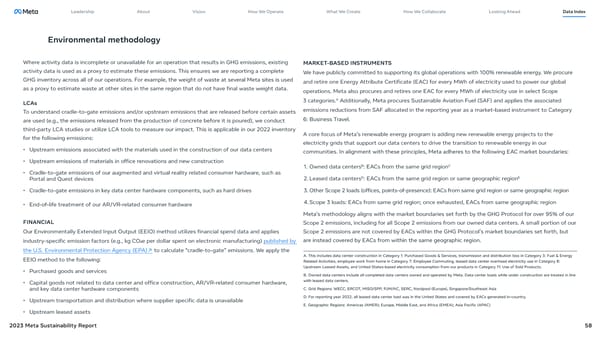Leadership About Vision How We Operate What We Create How We Collaborate Looking Ahead Data Index Environmental methodology Where activity data is incomplete or unavailable for an operation that results in GHG emissions, existing MARKET-BASED INSTRUMENTS activity data is used as a proxy to estimate these emissions. This ensures we are reporting a complete We have publicly committed to supporting its global operations with 100% renewable energy. We procure GHG inventory across all of our operations. For example, the weight of waste at several Meta sites is used and retire one Energy Attribute Certificate (EAC) for every MWh of electricity used to power our global as a proxy to estimate waste at other sites in the same region that do not have final waste weight data. operations. Meta also procures and retires one EAC for every MWh of electricity use in select Scope LCAs 3 categories.A Additionally, Meta procures Sustainable Aviation Fuel (SAF) and applies the associated To understand cradle-to-gate emissions and/or upstream emissions that are released before certain assets emissions reductions from SAF allocated in the reporting year as a market-based instrument to Category are used (e.g., the emissions released from the production of concrete before it is poured), we conduct 6: Business Travel. third-party LCA studies or utilize LCA tools to measure our impact. This is applicable in our 2022 inventory A core focus of Meta’s renewable energy program is adding new renewable energy projects to the for the following emissions: electricity grids that support our data centers to drive the transition to renewable energy in our • Upstream emissions associated with the materials used in the construction of our data centers communities. In alignment with these principles, Meta adheres to the following EAC market boundaries: • Upstream emissions of materials in office renovations and new construction B C 1. Owned data centers : EACs from the same grid region • Cradle-to-gate emissions of our augmented and virtual reality related consumer hardware, such as D E Portal and Quest devices 2. Leased data centers : EACs from the same grid region or same geographic region • Cradle-to-gate emissions in key data center hardware components, such as hard drives 3. Other Scope 2 loads (offices, points-of-presence): EACs from same grid region or same geographic region • End-of-life treatment of our AR/VR-related consumer hardware 4. Scope 3 loads: EACs from same grid region; once exhausted, EACs from same geographic region Meta’s methodology aligns with the market boundaries set forth by the GHG Protocol for over 95% of our FINANCIAL Scope 2 emissions, including for all Scope 2 emissions from our owned data centers. A small portion of our Our Environmentally Extended Input Output (EEIO) method utilizes financial spend data and applies Scope 2 emissions are not covered by EACs within the GHG Protocol’s market boundaries set forth, but industry-specific emission factors (e.g., kg CO2e per dollar spent on electronic manufacturing) published by are instead covered by EACs from within the same geographic region. the U.S. Environmental Protection Agency (EPA)↗ to calculate “cradle-to-gate” emissions. We apply the EEIO method to the following: A. This includes data center construction in Category 1: Purchased Goods & Services, transmission and distribution loss in Category 3: Fuel & Energy Related Activities, employee work from home in Category 7: Employee Commuting, leased data center overhead electricity use in Category 8: • Purchased goods and services Upstream Leased Assets, and United States-based electricity consumption from our products in Category 11: Use of Sold Products. B. Owned data centers include all completed data centers owned and operated by Meta. Data center loads while under construction are treated in line • Capital goods not related to data center and office construction, AR/VR-related consumer hardware, with leased data centers. and key data center hardware components C. Grid Regions: WECC, ERCOT, MISO/SPP, PJM/NC, SERC, Nordpool (Europe), Singapore/Southeast Asia • Upstream transportation and distribution where supplier specific data is unavailable D. For reporting year 2022, all leased data center load was in the United States and covered by EACs generated in-country. E. Geographic Regions: Americas (AMER); Europe, Middle East, and Africa (EMEA); Asia Pacific (APAC) • Upstream leased assets 2023 Meta Sustainability Report 58
 Meta 2023 Sustainability Report Page 57 Page 59
Meta 2023 Sustainability Report Page 57 Page 59